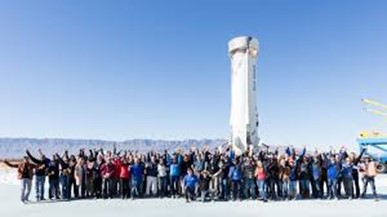Space Zoo Patrol – Large Launch Vehicles
By Jodie Guillen, Outreach and Engagement Manager, Blue Origin’s nonprofit, Club for the Future
- What is Blue Origin?
Blue Origin is a private space company whose vision is millions of people living and working in space for the benefit of Earth. The company is doing this by radically lowering the cost of accessing space, leveraging in-space resources, and inspiring future generations to pursue STEM careers.
- What is the name of the technology?
One of Blue Origin’s programs is called New Shepard. Named after Mercury astronaut Alan Shepard, the first American to go to space, New Shepard is our reusable suborbital rocket system.
- What does it do?
The suborbital launch vehicle is capable of carrying people and payloads to space and back above the Karman Line, the internationally recognized boundary of space.
- How does it work?
Crew Capsule
The pressurized crew capsule is environmentally controlled for comfort with room for six and the largest windows to have flown in space.
Ring & Wedge Fins
The fins are aerodynamically designed to stabilize the booster and reduce fuel use on its flight back to Earth.
Drag Brakes
The brakes deploy from the ring fin to reduce the booster’s speed by half on its descent from space.
Engine
The BE-3 (Blue Engine 3) propels the rocket to space and restarts for a controlled pinpoint landing on the pad. The uniquely throttleable engine slows the booster down to just 8 km/h (5 mph) for landing.
Aft Fins
These fins stabilize the vehicle during ascent, steer it back to the landing pad on descent, and guide the rocket through airspeeds of up to Mach 4.
Landing Gear
All rockets take off, not all rockets land. As a fully reusable rocket, the New Shepard booster uses landing gear that deploys for touchdown.
- How is it better than the older technology?
Protecting the Planet
Building a road to space starts with reusable vehicles and New Shepard is the first step in realizing that mission. The entire New Shepard system has been designed for operational reusability and minimal maintenance between flights from day one to decrease the cost of access to space and reduce waste. Nearly 99% of New Shepard’s dry mass is reused, including the booster, capsule, ring fin, engine, landing gear, and parachutes. New Shepard’s BE-3PM engine is fueled by highly efficient and clean liquid oxygen and hydrogen. During flight, the only byproduct of New Shepard’s engine combustion is water vapor with no carbon emissions.
- What classes should I take in school to work on this?
We encourage students to pursue STEAM (science, technology, engineering, the arts, and math) curriculum to build the future of life in space. Founded by Blue Origin in 2019, Club for the Future is a nonprofit foundation whose mission is to inspire K-12 students to pursue STEM careers for the benefit of Earth. Club for the Future actively engages students through multiple channels, including:
-
- Postcards to Space: Anyone can write or draw their vision on a postcard for what they think the future of life in space will look like. Blue Origin will fly the postcards on a future New Shepard mission, stamp them “flown to space,” and return them to the creators.
- Space-Themed Lesson Plans: Offers free educational content that is space-inspired. Students can learn about data literacy in partnership with Microsoft Excel, become space explorers through Project Ianos’s Expeditions, and learn about various space topics through Flip.
- Club Ambassador Program: At Blue Origin, every team member is known as a Club Ambassador. We empower them to connect with students in their communities to talk about their career path, role at Blue Origin, and the future of life in space.
- Pictures




